-
Cangzhou Yulong Steel Co., Ltd.
-
Phone:
+86 13303177267 -
Email:
admin@ylsteelfittings.com
- English
- Arabic
- Italian
- Spanish
- Portuguese
- German
- kazakh
- Persian
- Greek
- French
- Russian
- Polish
- Thai
- Indonesian
- Vietnamese
- Zulu
- Korean
- Uzbek
- Hindi
- Serbian
- Malay
- Ukrainian
- Gujarati
- Haitian Creole
- hausa
- hawaiian
- Hebrew
- Miao
- Hungarian
- Icelandic
- igbo
- irish
- Japanese
- Javanese
- Kannada
- Khmer
- Rwandese
- Afrikaans
- Albanian
- Amharic
- Armenian
- Azerbaijani
- Basque
- Belarusian
- Bengali
- Bosnian
- Bulgarian
- Catalan
- Cebuano
- China
- China (Taiwan)
- Corsican
- Croatian
- Czech
- Danish
- Esperanto
- Estonian
- Finnish
- Frisian
- Galician
- Georgian
- Kurdish
- Kyrgyz
- Lao
- Latin
- Latvian
- Lithuanian
- Luxembourgish
- Macedonian
- Malgashi
- Malayalam
- Maltese
- Maori
- Marathi
- Mongolian
- Myanmar
- Nepali
- Norwegian
- Norwegian
- Occitan
- Pashto
- Dutch
- Punjabi
- Romanian
- Samoan
- Scottish Gaelic
- Sesotho
- Shona
- Sindhi
- Sinhala
- Slovak
- Slovenian
- Somali
- Sundanese
- Swahili
- Swedish
- Tagalog
- Tajik
- Tamil
- Tatar
- Telugu
- Turkish
- Turkmen
- Urdu
- Uighur
- Welsh
- Bantu
- Yiddish
- Yoruba

Feb . 15, 2025 12:32 Back to list
different types of pipe flanges
Different types of pipe flanges play a crucial role in a wide variety of industries, ensuring sealed and efficient connections within plumbing, automotive, aerospace, and manufacturing sectors. Understanding their specific functions, materials, and applications can pave the way for ensuring long-term efficiency and safety in any piping system.
5. Lap Joint Flanges Featuring a two-part construction, lap joint flanges include a stub end which supports the flange over the pipe. This design allows for easy rotation and alignment, accommodating misalignments in systems where revising positioning is necessary. Their ease of replacement and alignment makes them suitable for systems requiring consistent inspection and alteration. 6. Threaded Flanges These flanges are exceptionally convenient for assembly and disassembly without welding, making them a favorite in environments where heat application is undesirable. Common in low-pressure, non-volatile environments, their threaded design is adept for scenarios involving smaller diameters. Selecting the right type of flange requires an understanding of the material it’s manufactured from and the intended application environment. Common materials include stainless steel, carbon steel, and alloy steel, each offering different benefits. For instance, stainless steel provides excellent corrosion resistance required in marine or chemical processes, while carbon steel offers robustness at a lower cost, suitable for high-temperature systems. Moreover, the selection process must consider factors such as pressure ratings and temperature limitations denoted by classes (150, 300, etc.), as these specifications impact a flange's performance and compatibility with existing systems. Professional expertise is indispensable when configuring a piping system. Engaging with experienced engineers and using high-quality, certified products ensures adherence to safety standards and optimal performance. Trust in authoritative sources and manufacturers can mitigate risks associated with poor quality products while maximizing operational efficiency. Additional considerations such as gasket and bolt selection play a pivotal role in the functionality of pipe flanges. Ensuring compatibility with flange materials can prevent leakage and maintain the integrity of the junction under operational stresses. In conclusion, the selection and application of different types of pipe flanges call for a balance of technical knowledge, material science, and judicious decision-making—especially in industries where reliability translates directly into safety and productivity. Comprehensive expertise paired with quality components fosters effective, durable, and efficient piping systems across all sectors.


5. Lap Joint Flanges Featuring a two-part construction, lap joint flanges include a stub end which supports the flange over the pipe. This design allows for easy rotation and alignment, accommodating misalignments in systems where revising positioning is necessary. Their ease of replacement and alignment makes them suitable for systems requiring consistent inspection and alteration. 6. Threaded Flanges These flanges are exceptionally convenient for assembly and disassembly without welding, making them a favorite in environments where heat application is undesirable. Common in low-pressure, non-volatile environments, their threaded design is adept for scenarios involving smaller diameters. Selecting the right type of flange requires an understanding of the material it’s manufactured from and the intended application environment. Common materials include stainless steel, carbon steel, and alloy steel, each offering different benefits. For instance, stainless steel provides excellent corrosion resistance required in marine or chemical processes, while carbon steel offers robustness at a lower cost, suitable for high-temperature systems. Moreover, the selection process must consider factors such as pressure ratings and temperature limitations denoted by classes (150, 300, etc.), as these specifications impact a flange's performance and compatibility with existing systems. Professional expertise is indispensable when configuring a piping system. Engaging with experienced engineers and using high-quality, certified products ensures adherence to safety standards and optimal performance. Trust in authoritative sources and manufacturers can mitigate risks associated with poor quality products while maximizing operational efficiency. Additional considerations such as gasket and bolt selection play a pivotal role in the functionality of pipe flanges. Ensuring compatibility with flange materials can prevent leakage and maintain the integrity of the junction under operational stresses. In conclusion, the selection and application of different types of pipe flanges call for a balance of technical knowledge, material science, and judicious decision-making—especially in industries where reliability translates directly into safety and productivity. Comprehensive expertise paired with quality components fosters effective, durable, and efficient piping systems across all sectors.
Next:
Latest news
-
ANSI 150P SS304 SO FLANGE
NewsFeb.14,2025
-
ASTM A333GR6 STEEL PIPE
NewsJan.20,2025
-
ANSI B16.5 WELDING NECK FLANGE
NewsJan.15,2026
-
ANSI B16.5 SLIP-ON FLANGE
NewsApr.19,2024
-
SABS 1123 FLANGE
NewsJan.15,2025
-
DIN86044 PLATE FLANGE
NewsApr.19,2024
-
DIN2527 BLIND FLANGE
NewsApr.12,2024
-
JIS B2311 Butt-Welding Fittings LR/SR 45°/90° /180°Seamless/Weld
NewsApr.23,2024











